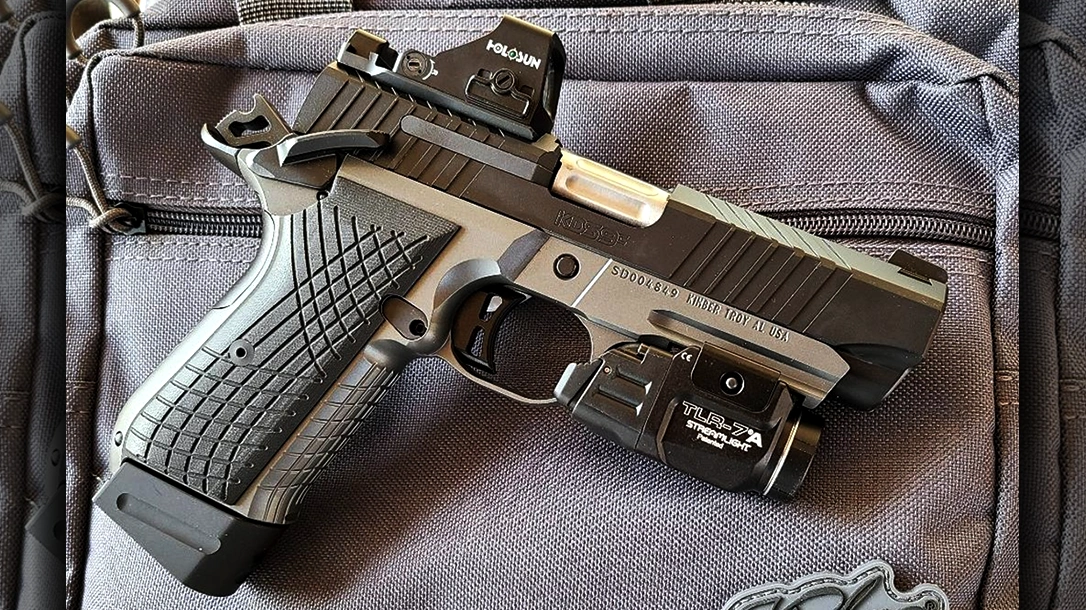Kimber is a relative newcomer to the American firearms scene, although it has been in operation for over forty years. The company started producing rifles and then added 1911 pistols. One such 1911 pistol is the KDS9c, which enjoyed fast popularity, so Kimber focused on enhancing the platform with the addition of a rail.
The Kimber KDS9c Rail 1911
Today, the company manufactures dozens of firearms in various lines like the 1911, R7 Mako, Micro 380 and 9mm pistols, K6s series revolvers, bolt action rifles like the Hunter, and even the Pepperblaster II—a non-lethal self-defense device.
One of Kimber’s newest handguns is the KDS9c. Built for personal protection, it is what I’ll term an advanced “Commander-style, 1911ish” pistol. The Kimber’s advantage over the Colt 9mm pistol is magazine capacity—15 or 18+1 vs. 9+1.
Advertisement — Continue Reading Below
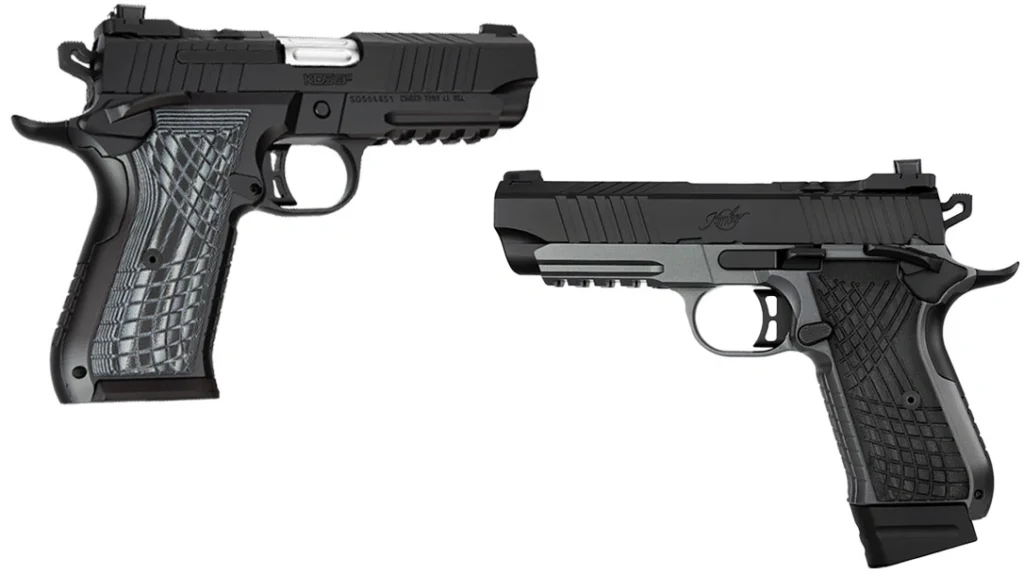
1911 Similarities and Dissimilarities
Both the Colt and Kimber have the same basic Browning-designed short recoil, cam/link operation, and a single action (SA) firing mechanism. Both have steel slides and aluminum frames, plus grip panels and a manual safety. This is about where the commonalities end.
The Kimber has a frame made of 7075 Aluminum and the slide is stainless steel. The slide features front and rear serrations and an external extractor. In addition, the top of the slide, ahead of the ejection port, is serrated.
Advertisement — Continue Reading Below
Forged from stainless steel, the barrel has a 1:10 left-hand twist, a 30-degree flush-cut deep crown at the muzzle, and is fluted along its length. At the muzzle, the barrel is bell-shaped to preclude the need for a barrel bushing.
The front sight is a TruGlo night sight mounted in a dovetail. The rear sight is part of the optic cover plate. It is also a night sight with a U-notch and is mounted in a dovetail. It slopes slightly forward so that it can be used to manipulate the slide in an emergency.
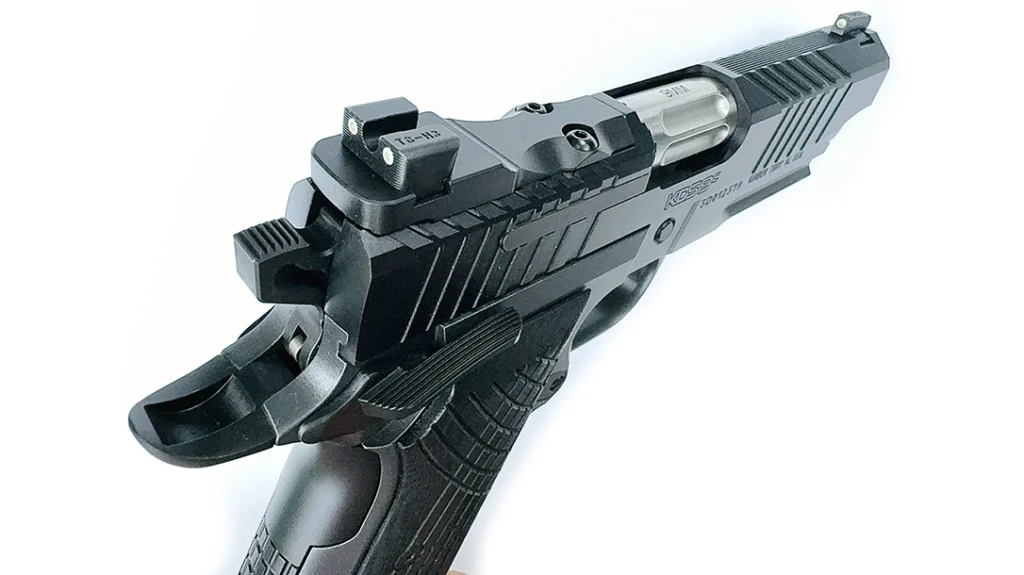
Advertisement — Continue Reading Below
Framing the KDS9c
The KDS9c frame has some features not found on most Commander-type 1911 pistols. Most obvious is the lack of a grip safety. Many old-time gunfighters who carried a 1911 pistol would often pin the grip safety, deactivating it. This was done in the event they had to get a quick hold on their pistol, which might not properly depress the safety and could prove deadly.
This Kimber 1911 does away with this safety altogether. However, it still has an extended tang to protect the web of the hand from hammer bite. The rounded mainspring housing just melds into the back-strap of the grip frame and is ergonomically pleasing.
Said mainspring housing and the front of the grip frame have crosshatch cuts to provide a secure grip. The black G-10 grip panels continue with this crosshatch pattern; plus, they are thin and blend into the grip frame.
Advertisement — Continue Reading Below
I would describe the hammer as a loop-type with a kidney-shaped cut that has a serrated flat at the top. Likewise, the thumb safety is extended and serrated on top. Pull weight on the skeletonized trigger is set at 3.5-4.5 pounds, and the face is serrated and about 0.25’ wide.
Inside the frame, there’s a 16-pound flat-wire recoil spring and a full-length guide, which should be able to handle the hottest loads. The magazine catch is in the usual location and is textured, oval-shaped, and reversible. Correspondingly, the slide stop is slightly extended but, like the rest of the controls, is unobtrusive.
The KDS9c Rail
My test gun from Kimber is the newest variation of the KDS9c. Ever mindful of its customers’ wants and needs, Kimber has added an integral Picatinny rail to the frame dust cover. This rail can be used for attaching tactical lights or laser sights. The company also added an ambidextrous thumb safety.
Advertisement — Continue Reading Below
I was sent the two-tone version of the KDS9c Rail for testing and evaluation. The slide’s finish is KimPro Black, while the frame’s finish is KimPro Gray.
It comes with a 15-round, flush-base magazine, plus an extended-base, 18-round magazine. My sample came in a box, with the pistol itself inside a gray nylon carrying case with zippered compartments. Also included is a safety padlock and hex wrenches to fit the grip panel and optic plate screws. There’s even a test target.
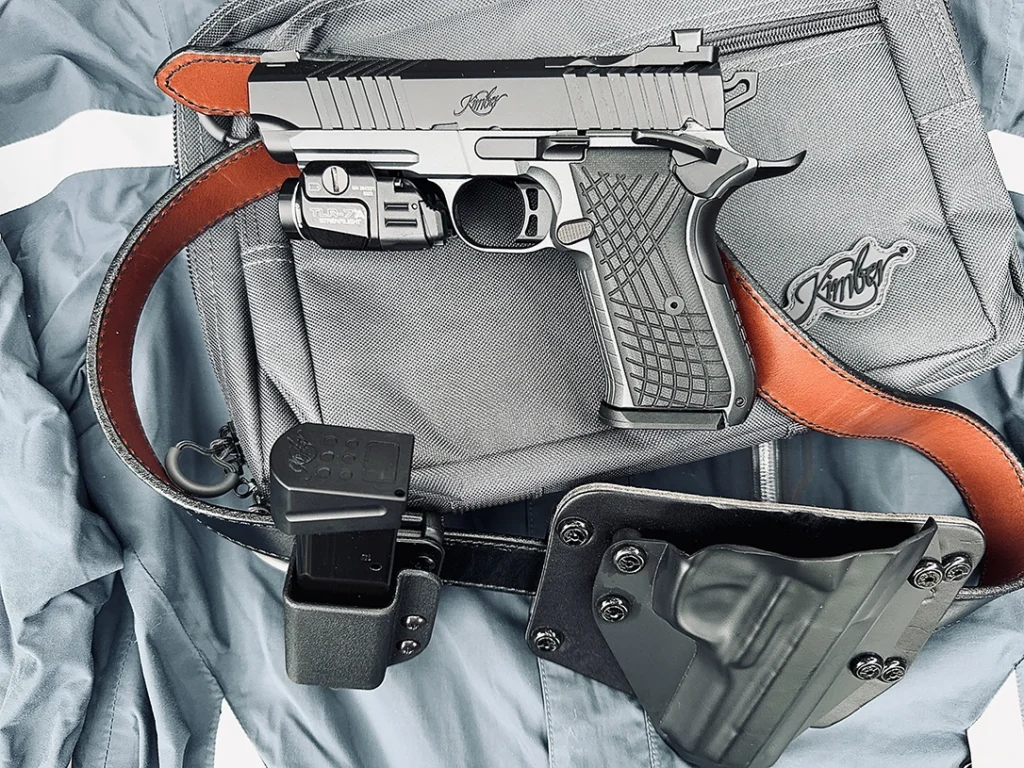
Advertisement — Continue Reading Below
A front-to-rear inspection revealed excellent fit and finish, with no visible flaws. The KDS9c Rail, to me, is a little easier to disassemble than the standard 1911 pistol. I suggest you read the owner’s manual before disassembly.
One note: Be careful removing the recoil spring, as you can inadvertently launch the recoil spring guide backward! Trust me.
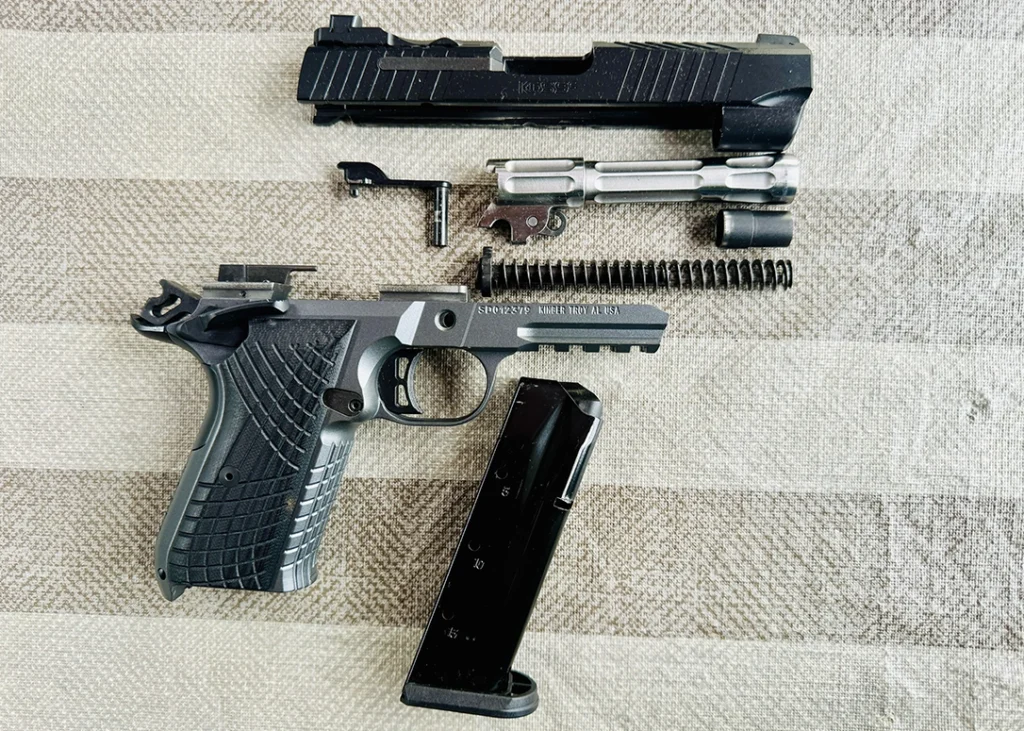
Advertisement — Continue Reading Below
Ammo and Accessories
For my T&E of the Kimber KDS9c Rail, I decided to go with six different 9mm loads. This included Black Hills 100 gr. Honey Badger +P, plus its 124 gr. JHP. Then there was Federal Train + Protect with a “Versatile” 115 gr. JHP.
From Hornady came a Subsonic load with a 147 gr. XTP-HP, then I received some Serbian-made PPU Range Master rounds with a 124 gr. FMJ bullet. Remington supplied its Range cartridges that have a 115 gr. bullet with an exposed lead nose and jacket-enclosed base.
I also needed a holster, a magazine pouch, and a tactical light. The holster had to fit a 1911 with a rail, so I used an early model Alien Gear Cloak OWB holster, which had a leather back and a Kydex tunnel.
Advertisement — Continue Reading Below
For a single magazine pouch, I selected a Blade-Tech Signature adjustable tension and belt width model made of Kydex. My gun belt was from DeSantis Gunleather—the B35 reversible model in 1.25-inch width.
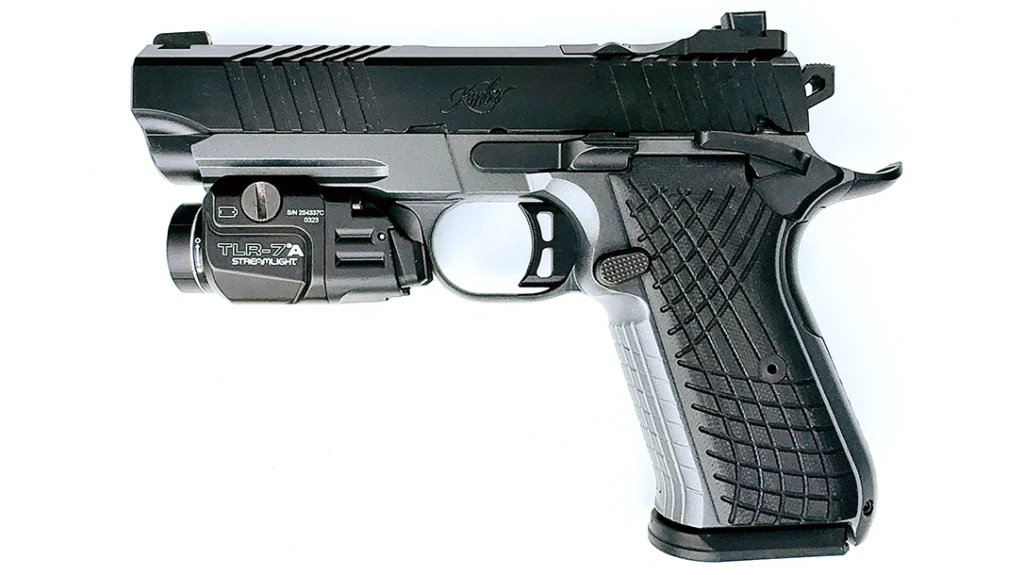
For the tactical light, I went with a Streamlight TLR-7A Flex, which produces 500 lumens and fits right on the KDS9c Rail with no issues. I decided not to use an MRDS as Kimber didn’t include adaptor plates, and the one on the pistol wouldn’t work with my Burris optical sight.
A photo I’d seen of a KDS9c Rail with an MRDS on the adaptor plate/sight indicated the sights weren’t high enough to co-witness. I know Mr. Murphy too well to put all my eggs in one basket, so to speak.
Range Work
First, I needed to get velocity readings from my test ammunition using the Kimber and my Oehler Model 35P chronograph. Then, I moved on to an accuracy potential evaluation.
Shooting was done from a sandbag rest on the range bench in SA mode. The distance was 15 yards, and I used 7.5 x 5.5-inch oval-shaped targets for three 5-shot groups. I had a bit of a problem with the old “4+1 Syndrome,” and on a few occasions, a flyer ruined a nice tight sub-1.5-inch group.
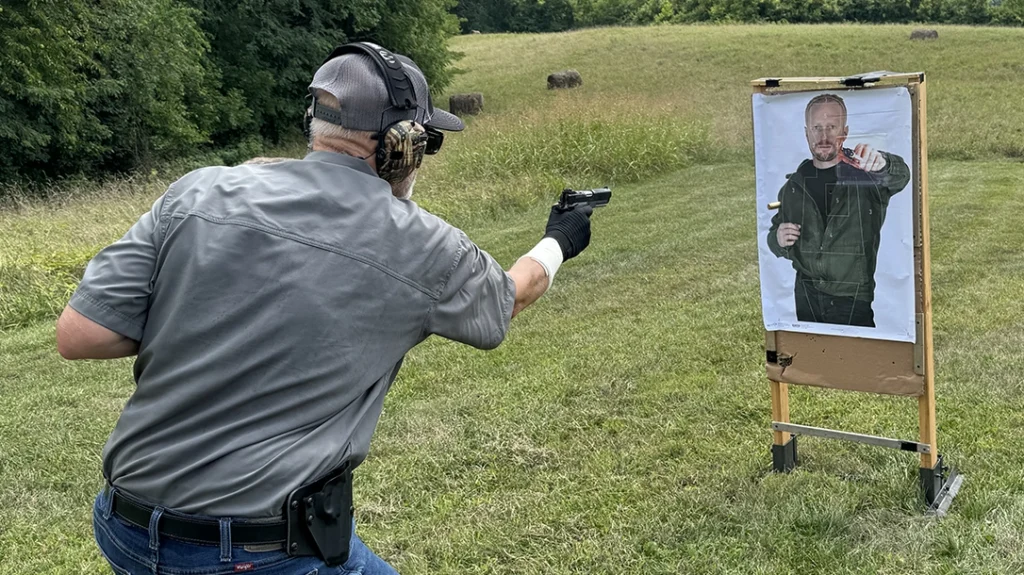
My official best 5-shot group measured 1.83 inches using the PPU Range Master 9mm cartridges. A close second was with the Federal Train + Protect loads, with a 1.87-inch cluster.
For the most part, the sights were shooting slightly to the right and a tad low. You can see all the performance data in the accompanying table (below). I also did some rapid-fire work at 7 yards to check reliability.
Running Drills with the KDS9c Rail
I generally shoot a 30-round combat-type course using the most accurate test ammo. So, I loaded up the two Kimber magazines with 15 rounds each of the PPU ammunition. With the belt, holster, and magazine pouch encircling my waist, I chambered a round in the KDS9c Rail and holstered it in Condition One—cocked and locked.
Just prior to this, I removed the Streamlight tactical light as I did not have a holster that would work with the light attached.
The course has four stages, which are shot at 3, 7, and 15 yards. Each stage starts with the pistol holstered, and after the shooting, a 360° threat assessment is performed before the pistol is slowly re-holstered.
Shooting begins close-in without sights, using one hand—transitioning from the strong to the support hand. Then, at 7 yards, a double-tap drill is followed by a body armor or failure drill (2 center-mas and 1 headshot).
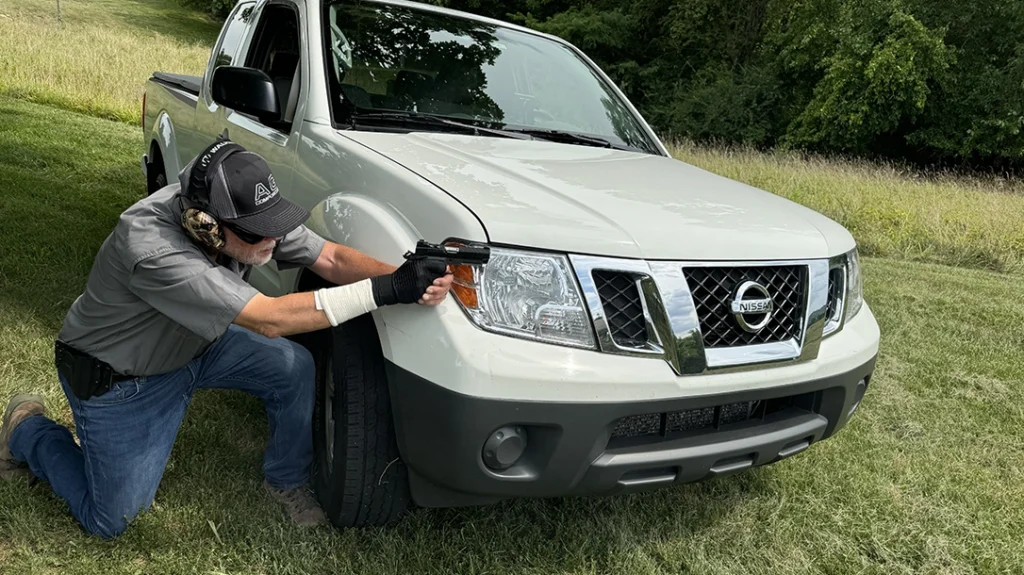
At 15 yards is standing and kneeling barricade shooting. On this occasion, I decided to use the front of my pickup truck as the barricade. My target was a realistic “bad guy” silhouette with 3-, 4- and 5-point scoring areas.
My score tallied 138/150—a 3-pointer came with my first left-hand only shot at 3 yards.
Impressions
Everything I have to say about the Kimber KDS9c Rail—plus the ammo and gear—is favorable. I did the chronograph and accuracy testing with the Streamlight TLR-7a light in place. It never came loose and worked famously.
This is the most comfortable to hold and shoot 1911-type pistol I’ve evaluated. All the controls are easy to reach with the thumb without shifting the grip. Likewise, the magazines ejected when the catch was pressed, and there were zero malfunctions. Finally, as I don’t do a lot of Condition One shooting, I had no issues with the thumb safety.
If I were in the market for an SA autopistol for defense use, the Kimber KDS9c Rail would be a top contender.
For more information, please visit KimberAmerica.com.
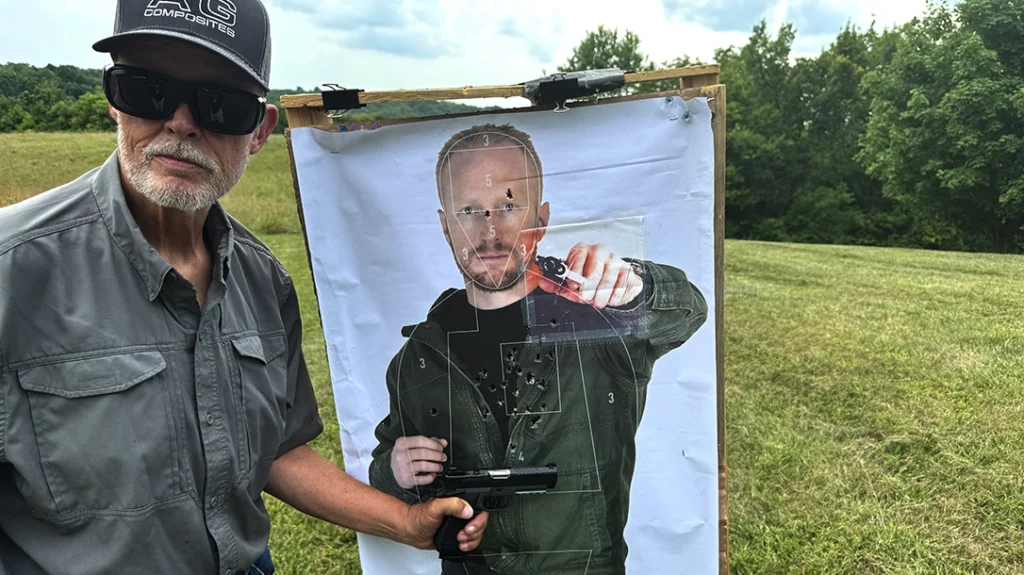
Kimber KDS9c Rail 1911 Specs
| Mechanism | Single action, short-recoil operation |
| Caliber | 9mm Luger |
| Capacity | 15+1 and 18+1 cartridges |
| Barrel | 4.09 in. |
| Overall Length | 7.75 in. |
| Empty Weight | 29.6 oz. |
| Sights | TruGlo fixed front/rear night sights, optics ready |
| Finish | Slide KimPro Black, frame KimPro Gray |
| Stocks | Black crosshatch G10 |
| MSRP | $ 1,903.00 |
Performance
| Cartridge | Ave. Velocity | Best Group | Average Group |
| Black Hills 100 gr. Honey Badger +P | 1,237 FPS | 2.26” | 3.08” |
| Black Hills Factory New 124 gr. JHP | 1,178 FPS | 2.77” | 3.62” |
| Federal Train + Protect 115 gr. V-JHP | 1,132 FPS | 1.87” | 2.65” |
| Hornady Subsonic 147 gr. XTP-HP | 949 FPS | 1.91” | 2.55” |
| PPU Rangemaster 124 gr. FMJ | 1,104 FPS | 1.83” | 2.49” |
| Remington Range 115 gr. FNEB* | 1,135 FPS | 2.21” | 2.65” |
NOTE: Bullet weight measured in grains, velocity in feet per second 10 ft. from the muzzle by an Oehler Model 35P chronograph, and accuracy in inches for three 5-shot groups at 15 yards. * FNEB: Flat-Nosed Enclosed Base.
